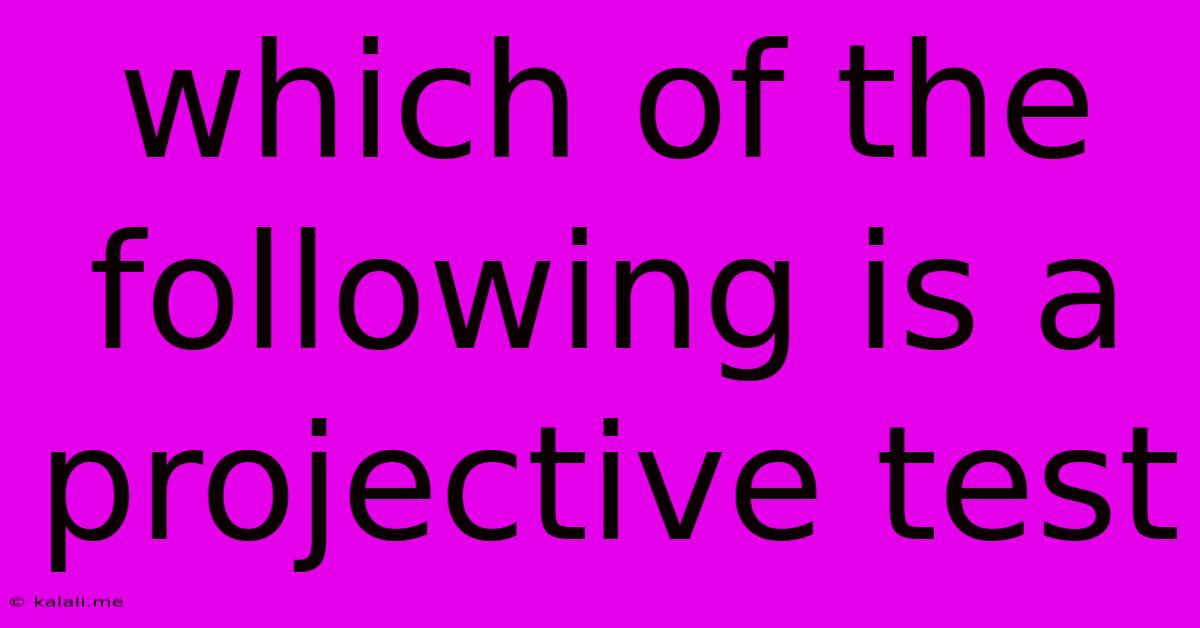Which Of The Following Is A Projective Test
Kalali
Jun 13, 2025 · 3 min read

Table of Contents
Which of the Following is a Projective Test? Understanding Projective Techniques in Psychology
Projective tests are a category of psychological assessment tools that present ambiguous stimuli to individuals, allowing them to project their unconscious thoughts, feelings, and motivations onto the stimuli. These tests are designed to tap into deeper aspects of personality that may not be readily accessible through self-report measures. Understanding which tests fall under this category is crucial for psychologists and anyone interested in personality assessment. This article will explore what constitutes a projective test and provide examples to clarify the concept.
What Makes a Test "Projective"?
The defining characteristic of a projective test is its use of ambiguous stimuli. Unlike objective tests with clear-cut right or wrong answers, projective tests lack structured responses. This ambiguity allows for a wider range of interpretations, reflecting the individual's unique perspective and underlying psychological processes. The responses are then analyzed to infer personality traits, motivations, and emotional states. The interpretation relies heavily on the clinician's expertise and judgment. Key characteristics include:
- Ambiguous Stimuli: The stimuli are purposefully vague, lacking clear meaning. This encourages the individual to project their own internal world onto the stimuli.
- Subjective Interpretation: The scoring and interpretation of the responses are subjective, relying on the clinician's clinical experience and theoretical framework.
- Unconscious Exploration: The primary goal is to uncover unconscious thoughts, feelings, and conflicts that might not be consciously accessible.
Examples of Projective Tests:
Several well-known psychological assessments fall under the umbrella of projective tests. Some of the most commonly used include:
-
Rorschach Inkblot Test: This classic projective test presents a series of inkblots, and individuals are asked to describe what they see. The responses are analyzed for themes, patterns, and the way the individual perceives the ambiguous shapes. This test is known for its exploration of personality dynamics and underlying conflicts.
-
Thematic Apperception Test (TAT): The TAT uses a series of ambiguous pictures depicting various scenes and situations. Individuals are asked to create a story for each picture, including the characters, their motivations, and the outcome. The narratives reveal underlying needs, fantasies, and interpersonal relationships.
-
Sentence Completion Tests: These tests present incomplete sentences, and individuals are asked to finish them. The responses provide insights into their attitudes, beliefs, and feelings. This method is often used in conjunction with other assessment tools.
-
Draw-a-Person Test: As the name suggests, individuals are asked to draw a person. The details of the drawing, such as the size, features, and proportions, are analyzed to provide insights into self-perception, body image, and emotional state. Variations include drawing a family or a house.
Which is NOT a Projective Test?
To fully understand projective tests, it's equally important to identify tests that don't fall into this category. Objective personality tests, like the Minnesota Multiphasic Personality Inventory (MMPI) or the Big Five Inventory (BFI), are characterized by structured questions with predetermined scoring systems. These tests rely on self-report and are less open to subjective interpretation than projective tests.
Conclusion:
Projective tests offer a unique window into the unconscious mind, providing valuable insights into personality and psychodynamics. However, their subjective nature and potential for bias mean they are often used in conjunction with other assessment methods for a more comprehensive evaluation. Understanding the defining characteristics of a projective test is crucial for interpreting results accurately and ethically. The Rorschach, TAT, Sentence Completion, and Draw-a-Person tests are prime examples, while objective personality inventories are distinctly different.
Latest Posts
Latest Posts
-
The Normal Rbc Graveyard Is The Liver
Jun 14, 2025
-
Can You Reschedule A Sat Test
Jun 14, 2025
-
Able To Be Drawn Into Wire
Jun 14, 2025
-
Which Of The Following Statements Is True Regarding
Jun 14, 2025
-
What Is The Least Common Multiple Of 20 And 40
Jun 14, 2025
Related Post
Thank you for visiting our website which covers about Which Of The Following Is A Projective Test . We hope the information provided has been useful to you. Feel free to contact us if you have any questions or need further assistance. See you next time and don't miss to bookmark.